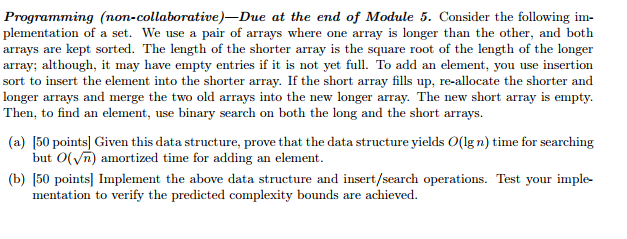Answered step by step
Verified Expert Solution
Question
1 Approved Answer
WRITE IN JAVA Programming (non-collaborative)-Due at the end of Module 5. Consider the following im- plementation of a set. We use a pair of arrays
WRITE IN JAVA
Programming (non-collaborative)-Due at the end of Module 5. Consider the following im- plementation of a set. We use a pair of arrays where one array is longer than the other, and both arrays are kept sorted. The length of the shorter array is the square root of the length of the longer array; although, it may have empty entries if it is not yet full. To add an element, you use insertion sort to insert the element into the shorter array. If the short array fills up, re-allocate the shorter and longer arrays and merge the two old arrays into the new longer array. The new short array is empty. Then, to find an element, use binary search on both the long and the short arrays. (a) [50 points] Given this data structure, prove that the data structure yields O(lgn) time for searching but O(Vn) amortized time for adding an element. (b) [50 pointsl Implement the above data structure and insert/search operations. Test your imple- mentation to verify the predicted complexity bounds are achieved. Programming (non-collaborative)-Due at the end of Module 5. Consider the following im- plementation of a set. We use a pair of arrays where one array is longer than the other, and both arrays are kept sorted. The length of the shorter array is the square root of the length of the longer array; although, it may have empty entries if it is not yet full. To add an element, you use insertion sort to insert the element into the shorter array. If the short array fills up, re-allocate the shorter and longer arrays and merge the two old arrays into the new longer array. The new short array is empty. Then, to find an element, use binary search on both the long and the short arrays. (a) [50 points] Given this data structure, prove that the data structure yields O(lgn) time for searching but O(Vn) amortized time for adding an element. (b) [50 pointsl Implement the above data structure and insert/search operations. Test your imple- mentation to verify the predicted complexity bounds are achieved
Step by Step Solution
There are 3 Steps involved in it
Step: 1

Get Instant Access to Expert-Tailored Solutions
See step-by-step solutions with expert insights and AI powered tools for academic success
Step: 2

Step: 3

Ace Your Homework with AI
Get the answers you need in no time with our AI-driven, step-by-step assistance
Get Started


